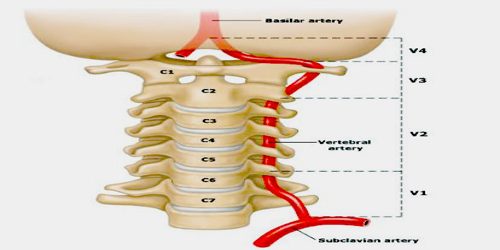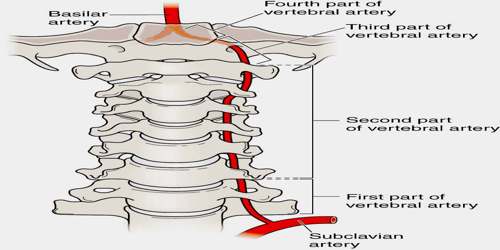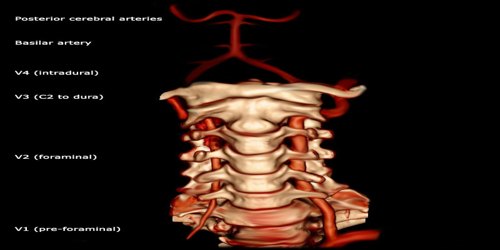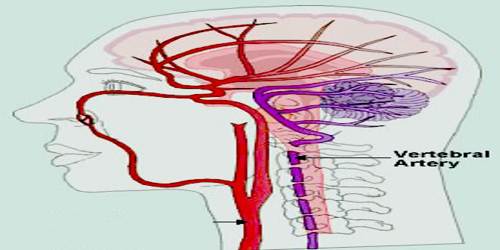Vertebral Artery
Definition
Vertebral artery is one of the main arteries at the base of the neck and is the first branch of the subclavian artery. This system provides important areas of the brain with blood. As the supplying component of the vertebrobasilar vascular system, the vertebral arteries provide supply blood to the upper spinal cord, brainstem, cerebellum, and posterior part of brain.

The vertebral artery can be divided into four divisions:
- The first division runs posterocranial between the longus colli and the scalenus anterior. The first division is also called the ‘pre-foraminal division’.
- The second division runs cranial through the foramina in the cervical transverse processes of the cervical vertebrae C2. The second division is also called the foraminal division.
- The third division is defined as the part that rises from C2. It rises from the latter foramen on the medial side of the rectus capitis lateralis, and curves behind the superior articular process of the atlas. Then, it lies in the groove on the upper surface of the posterior arch of the atlas, and enters the vertebral canal by passing beneath the posterior atlantoöccipital membrane.
- The fourth part pierces the dura mater and inclines medial to the front of the medulla oblongata.
Structure and Functions of Vertebral Artery
A plexus of nerve fibers surrounds the vertebral artery and the first part arises from the subclavian artery to the sixth cervical vertebra’s transverse process. It goes to the upper six cervical vertebrae’s transverse processes to the skull by going up into the foramina. It enters the skull by way of the foramen magnum, in front of the ligamentum denticulatum’s uppermost tooth. Then above it turns between the hypoglossal nerve and below, the first cervical nerve, and continues to the medulla oblongata’s anterior surface. It forms the basilar artery by uniting with the other side at the lower border of the pons. Here it becomes intracranial.

The origin of the vertebral arteries is usually from the posterior superior part of the subclavian arteries bilaterally, although the origin can be variable:
- Brachiocephalic artery (on the right)
- Aortic arch: 6% of cases, most on the left
The VA is normally 3-5 mm in diameter and the ostium is the most common site of stenosis.
When the origin is from the arch, then it is common for the artery to enter the foramen transversarium at a level higher than normal (C5 instead of C6).
The vertebral artery has two sets of branches: cervical and cranial. The neck is where the cervical branches are given off and the cranium is where the cranial branches are given off. The muscular and lateral spinal arteries are the cervical branches. The lateral spinal ones divide into two branches by way of the intervertebral foramina. These two branches supply the bodies of the vertebrae, the spinal cord, and its membranes. Before the vertebral artery hits the posterior ligament of the occipito-atloid the muscular branches are given off. These branches service the neck’s deep muscles. The occipital and the ascending and deep cervical arteries merge with these branches.

Both vertebral arteries, the one on the left and the other on the right, rise up from the subclavian arteries on a path parallel to the carotid artery. Inside the skull, the two vertebral arteries merge to form the basilar artery, which is among the arteries supplying blood to the brain.
Amongst various vertebral artery diseases, the most common one is cerebrovascular insufficiency, which is caused by a narrowing of one or both of the arteries and can ultimately lead to a stroke.
Reference:









![Report on One Bank LTD [PART-1]](https://assignmentpoint.com/wp-content/uploads/2013/03/one-bank1-110x55.jpg)






